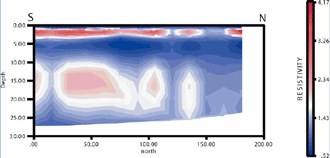Principal Investigator: Mitch Lyle (BSU)
To improve imaging capabilities, a transient electromagnetic (TEM) survey was performed in the same
area as the 3-D seismic survey. The TEM method measures the conductivity of the subsurface as
a function of depth by inducing an electromagnetic field into the subsurface. We conducted a 3-D TEM
survey to determine the resistivity structure of the linear spring trend and to understand the
left-stepping offset in spring positioning.
 Resistivity profile in the vicinity of the spring step-over region north of Borax Lake.
Resistivity profile in the vicinity of the spring step-over region north of Borax Lake. [Click image to enlarge] |
Preliminary results show a high resistivity layer from the surface to a depth of 3 m. A low resistivity layer exists
from 3 m down to 10 m, and a layer of increased resistivity is present between 10 to 23 m depth. Assuming high resistivity correlates with low permeability and/or unsaturated conditions, a possible geologic model
for this section is a thin vadose zone overlying a spring water saturated zone. Note that low resistivity zones come to the surface in the vicinity of the hot springs (near 120 m and 160 m). This most likely is
the water-saturated zone, and indicates that fluids in the fault are highly conductive. A lower conductivity
zone, near the center of the profile at a depth of 10-20 m, may be indicative of the underlying geologic structure.
Magnetic Susceptibility Model
We inverted the magnetic data to determine 3-D magnetic susceptibility distribution for the survey area.
The predicted data from the model fit the observed data well given a noise assumption of 3 nT. The model from the inversion
of the magnetic data shows tubular structures that start at a depth of 200 m and continue to the surface. These tubular
structures are the low susceptibility zones that may represent conduits for upflowing geothermal water. The zones of
low susceptibility correlate with the location of the hot springs, suggesting the validity of the magnetic inversion.

